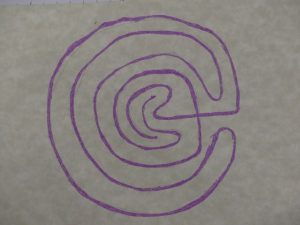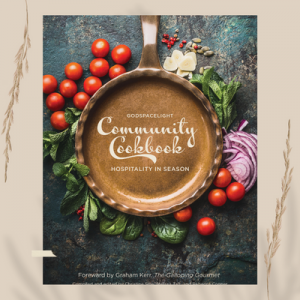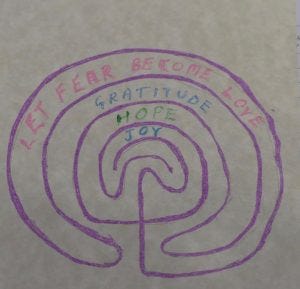A couple of days ago a friend sent me this photo of a finger labyrinth at the cathedral in Lucca, Italy which was built in the 11th century. The labyrinth is on the wall under the portico on the right side. The day after that I put together my spiritual travel kit with the knitted finger labyrinth as an important element. When I woke in the middle of the night a couple of days before we started travelling, I sat in the dark and pulled out one of my finger labyrinths to help me relax and calm my mind. All of this made me realize that finger labyrinths needed to be the spiritual practice for this week and so I adapted this article which I wrote several years ago.
 Jesus, friend, companion, lover of my soul,
Jesus, friend, companion, lover of my soul,
The One who walks beside me,
Wherever I might go.
The One who hold me close,
When despair lurks at the door.
Who comforts me
When the way is rough,
And I stumble over rocks
I did not see.
Walk with me now,
Through all the twists and turns of life,
When clouds obscure the way.
When what once seemed close,
Now looks so far away,
Walk with me,
Down paths of light
And trails of night,
Help me paint rocks,
To glow in the dark.
No longer obstacles but markers on the Way.
Walk with me till I trust in you,
And journey towards the life,
At the centre of your love.
To be honest when I first read about finger labyrinths while working on my book Return to Our Senses, this seemed a very strange way to pray. Most of the articles I read suggested that the best way to trace out a finger labyrinth is with a finger from your non-dominant hand. It seemed weird but evidently research suggests that our non-dominant hand has better access to our intuition.
Much to my surprise, I found that it really did help me focus and often brought intuitive inspiration when I was grappling with challenging questions. As I “walk” my labyrinth I still often recite the prayer above which is one I adapted from a previous one I wrote for Return to Our Senses.

Since then, I have gone a lot further and allowed the labyrinth to inspire my journalling, my preparation for Holy week and Easter, my problem solving for challenging questions. Sometimes I sketch a crude labyrinth in my journal then write the words impressed on me over the previous few weeks as a pathway for me to follow through the coming weeks. Out of this has come new practices for the following season.
In the Middle Ages, it is believed that walking the labyrinth was often used as a form of pilgrimage for those who could not afford the time or the money to leave their homes for an extended time to walk to the Holy Land. Though this usually involved walking a labyrinth in the church or its grounds, finger labyrinths were evidently used in the same way. People walked the labyrinth with the same intentionality that pilgrims did. The inward walk was a journey toward a closer sense of the presence of God, the outward walk, a journey back into the community, taking the benefits of the walk into the ongoing journey of our lives.
In its simplest form a labyrinth walk is used as a simple form of meditation for individuals and groups. Because it requires no figuring out, one can simply walk, allowing the mind to quiet, and let the body or the finger to take over. We may walk, dance, or crawl the path, doing what the body calls forth; there are no rules, there is no right or wrong way.
Many churches and religious institutions, including Calvin College I know encourage their congregations and students to walk the labyrinth during Lent and Holy Week as a meditative walk toward the Cross – an alternative to Stations of the Cross for many people. Here are some ideas on how to do this and pilgrim paths in the U.K. has produced this excellent brochure for a Holy Week labyrinth walk.
Finger Labyrinths.
Some of you probably noticed that my finger labyrinths often feature prominently in the background to my sacred space. I have 2 in particular that are permanent fixtures. One is an 11 circuit Chartres style labyrinth, so named because it is modeled after the labyrinth set in the stone floor in the nave of Chartres Cathedral in France. The other is a Celtic labyrinth given to Tom and I as a gift for our years of service with Mustard Seed Associates. These labyrinths sit, prominently displayed and ready to be taken down and used whenever I get writers block or puzzle over a challenging question.
Finger Labyrinths for Questioning.
While modern hospitals and nursing homes now advertise large and visible outdoor labyrinths, many more healing institutions are quietly bringing finger labyrinths inside. One simple reason is that many patients are confined to beds or wheelchairs. Finger labyrinths have advantages beyond convenience and accessibility. People use finger walks not just for prayer and healing, but also to get ready for meetings, break through writer’s block, cure insomnia, and for many other reasons known only to them. They provide a legitimate path for questioning and problem solving.
I love finger labyrinths – both walking and creating them and would heartily recommend them to you. They are great because of their portability. I even have one I can carry in my pocket at times. There are many patterns to these so you might like to download a few and experiment with how they might help you find solutions to the questions you are grappling with you. You might just like to color your labyrinth in different colors or write the words that come to you as you walk it along the pathway.
If you have time, create your own finger labyrinth, this is a meditative exercise in itself. Part of what I love is that we can create labyrinths using whatever art medium inspires us. Here are instructions on creating a simple labyrinth, a very inspiring practice I often use in workshops.
One of my favourite set of instructions for making a finger labyrinth is from Heather Plett who has made labyrinth design a piece of art. Other method I have not tried yet is making a finger labyrinth with play dough or out of fabric. Or you might like to use this method which uses yarn, tissue paper and glue to create a very beautiful decorated labyrinth. A fun activity with kids. Alternatively, try knitting a labyrinth . There are lots of patterns out there for knitting. Here is another that looks intriguing.
What Is Your Response?
Here is a simple finger labyrinth exercise you might like to experiment with. If you don’t own a finger labyrinth, download or draw a simple pattern. The whole process of creating your own labyrinth is meditative too.
Sit in a quiet place with your hands in your lap, palms facing upward. Take a few breaths in and out until you feel at peace in your soul.
Recite the prayer above several times and relax into the presence of God
Form a question you are grappling with or use the one I suggested during Lent a few years ago: What am I afraid of? Place a finger from your non-dominant hand at the entrance to the labyrinth. Prayerfully ask your question. Invite the holy spirit of God to guide and instruct you on your journey.
Trace the circuit with your finger. Stay open to whatever presents itself: feelings, sensations, memories, ideas. Pause at any time to breathe, focus on a thought or memory or just to relax into the labyrinth and your questioning. At the center of the labyrinth, sense your connection to your own centre and to the the centering presence of God. Acknowledge the Holy Spirit, the heavenly counselor directing your thoughts and exploration. Relax, pray, sing. Repeat your question and wait on the Holy Spirit to guide you.
Trace your way out, staying open to whatever comes up for you. Now you might like to change you question to What would I do if I was not afraid? When your walk is done, place both hands on the labyrinth, take some deep breaths in and out, and give thanks to God for whatever you learned and experienced.

Godspacelight Community Cookbook
Godspacelight Community Cookbook Digital Download
This downloadable PDF version of the Godspacelight Community Cookbook is filled with recipes created by readers, authors, and friends of Godspacelight. Contributors from the U.S., Canada, Australia, the U.K., Norway, Malta and South Africa provided not only recipes but also lots of fun stories and anecdotes to go with their recipes. These stories are inspiring to read as they give us insights both into the contributors’ lives and their cultures. And the recipes themselves are delicious.


